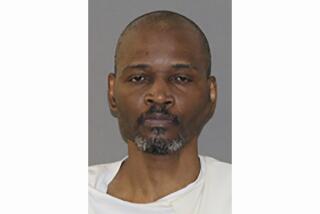Expert Disputes Theory of ‘Execution’ by Kreutzer
- Share via
A nationally known forensic pathologist Monday disputed testimony suggesting that James Ray Spencer was executed at the Big Oak Ranch by his father-in-law, Herman (Rock) Kreutzer.
Larry Stillwell, a former ranch employee, has testified that Spencer, 32, was on his knees or in a crouching position, pleading for his life, when he was fatally shot by Kreutzer, 48, on April 11, 1984.
But Charles Petty, the chief medical examiner in Dallas County, Texas, testified Monday that some of the wounds, particularly the fatal leg wound that caused Spencer to bleed to death, were not consistent with an execution-type killing. He appeared as a defense witness.
“There’s nothing about this that looks like an execution,” said Petty. “In an execution murder, one has an outstanding goal: to make certain a person is dead. An execution is often done at the head or at very close range.” He added there was no evidence of a coup de grace on the body.
Petty testified that Spencer was probably upright when he was shot from a distance of 2 1/2 to 4 feet. He based his opinion on a blood-soaked athletic sock found on Spencer’s body. Petty said the bloody sock indicates that Spencer may have been standing up when he was shot in the right thigh, and the blood flowed down Spencer’s leg into his western boot.
Spencer was wounded several times before he died, and Petty said that one bullet in question traveled downward, penetrating and exiting through the chest, instead of upward as originally reported by the San Diego County coroner’s office.
He said that he used a testing method called Energy Dispersive X-ray Analysis to examine Spencer’s clothing and determine the path of the bullet. Spencer, who was shot at least five times in the body, bled to death when the fatal bullet cut the femoral artery in his right leg.
Deputy Dist. Atty. Brian Michaels argued that the fatal wound was actually caused by the bullet that Petty said entered in a downward angle and exited through the chest. After exiting, the bullet continued and penetrated the thigh, while Spencer was kneeling or crouching down, Michaels said.
In the original autopsy report, pathologist Hormez Guard said the bullet in question traveled in an upward direction. Coroner David J. Stark said Monday that Guard later amended his report to show the bullet traveling in a downward path. Guard testified at Kreutzer’s trial that he was pressured to change the report so it would conform to the prosecution’s theory of the case.
After he testified, Petty told a reporter that it was difficult for Guard to determine the bullet’s path because Spencer’s clothing was not available to the coroner’s office at the time. Stark said that Guard decided to amend his report after inspecting Spencer’s clothes.
According to Petty, an experienced pathologist, using the latest in technology, can tell if a bullet hole in a piece of clothing is an entry or exit hole by studying the edges. Bullets leave different telltale signs when penetrating and exiting through clothing, said Petty.
The folksy Petty, who testified for two hours, supervised identification of the victims of last week’s Delta Air Lines crash in Dallas.
More to Read
Sign up for Essential California
The most important California stories and recommendations in your inbox every morning.
You may occasionally receive promotional content from the Los Angeles Times.










